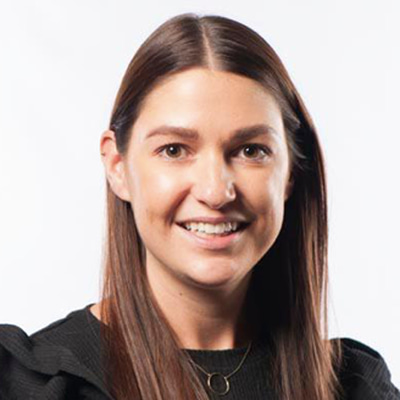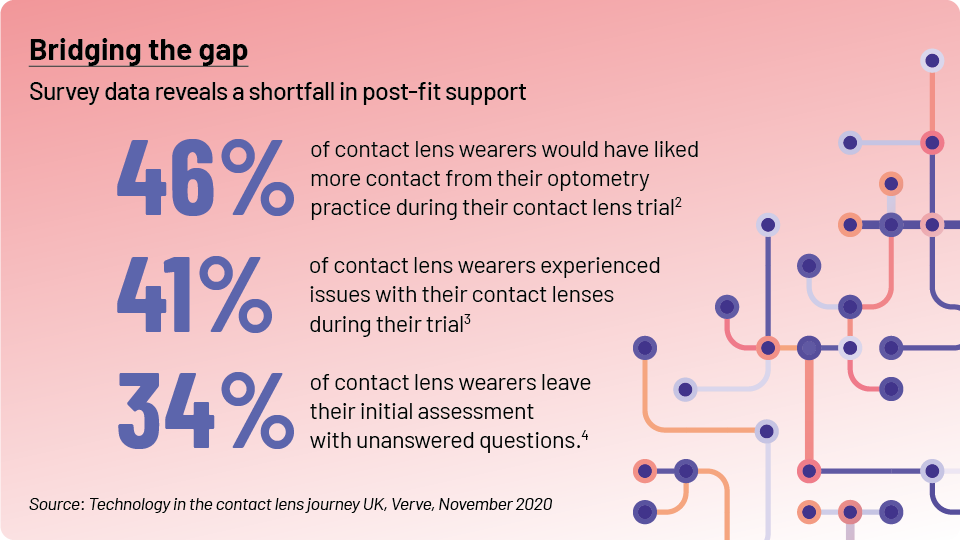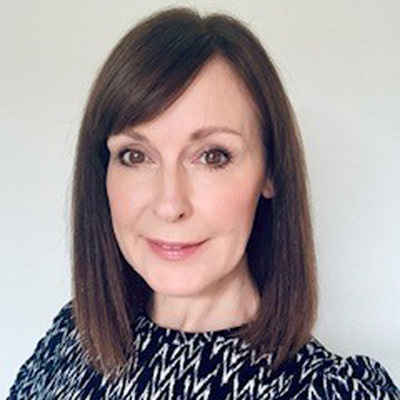- OT
- Life in practice
- Business management
- Embracing technology
Contact lens guide
Embracing technology
OT explores how technology can enhance and streamline the contact lens patient journey

07 December 2023
Picture the scene. Celine Dion is in the charts, mobile phones can be used as paperweights and the shrill cacophony of a dial up connection heralds the arrival of the internet to a select few households.
It is 1995: the year daily disposable contact lenses were first introduced to the market.
Fast-forward to 2023, and technology has become embedded in our daily lives.
We socialise, learn, work and shop online.
In the context of a proliferation of online tools, contact lens care has evolved to provide support beyond the practice floor.
Whether sharing application and removal videos, or checking in to see how patients are getting on with their lenses through a video call, technology can provide an extra layer of accessibility and convenience for patients.
OT spoke with eye care professionals for their tips on how to make sure that contact lens care meets patient expectations in an increasingly digital world.
A wealth of information
Optometrist and ophthalmic director at Specsavers Northallerton, Rebecca , described two-way text messaging as a “great tool” for opening communication with patients.

“In a sea of online information being able to signpost easily accessible, honest information is invaluable. It enables patients to unlock the help they need in their own time, on their own terms,” she emphasised.
Technology is also used to check in with patients – whether they are new wearers or existing contact lens wearers trying a new lens.
“Caring after the fit comes in many forms – email or text to remind patients we are here for anything they need, or arranging a call at a time that suits them,” Troughton said.
By being proactive, Troughton and her team are able to pre-empt any issues that might develop and assess whether a clinical review is required.
“In a rural community practice with a huge geographical spread this can avoid wasted trips to the practice, saving our patient’s time and travel costs,” she said.
She shared that patients value this attention from the practice.
“In a busy world, checking in a few days later for a catch up to iron out any niggles or answer any questions makes a lasting impression,” Troughton emphasised.
Age hasn’t been a barrier to using the technology
Meeting patient expectations
Clinical lead optometrist at Lynne Fernandes Optometrists, Rebecca Donnelly, shared that a week after a lens fit, each contact lens patient will receive a phone call to ask about their vision and comfort in contact lenses.
69%
of contact lens wearers would be open to using technology during their contact lens journey1
Donnelly emphasised that there is patient demand for contact lens services incorporating the use of technology.
“They expect the use of teleoptometry, even if that is just a phone call, email or text,” she said. Donnelly added that more frequent engagement with contact lens wearers can help to improve compliance and reduce the chance of drop out.
A new way of working
Faced with a backlog of contact lens appointments during the pandemic, Donnelly and her colleagues began offering video consultations to ensure that they could continue to provide high-quality care.
“We wanted to be able to check in on our patients and ensure they could still order their lens supply and also have the opportunity to voice any concerns regarding their vision, comfort or care regime,” Donnelly shared.
Following a positive response to this form of support, asymptomatic patients with an up-to-date eye examination and soft contact lens specification were offered a choice between an in-person appointment and a video call.
“The majority of patients were keen to have remote follow up,” Donnelly said.
While this form of appointment is currently on pause due to staffing considerations, Donnelly hopes that it will return as an established procedure – rather than a short-term response to the pandemic.
“I do think this will become the norm in eye care and as remote care is being rolled out in multiples it is very important for the independent optometrist to be aware of the situation and how they can adapt,” she said.

Vision Express remote eye care team leader, Amanda Moore, works as part of a group of contact lens opticians who provide remote post-fit follow up appointments to patients.
Moore, who started working as a contact lens optician (CLO) in 1994, shared that it is important that care evolves alongside developments in contact lenses and technology.
“It is perhaps not as relevant on every occasion to attend in store. We can mix and match. We can have online check ins to make sure that everything is OK – if it is not, we can signpost back to store,” Moore shared.
Beyond bricks and mortar
Moore and her team are careful to take a detailed history and ask follow-up questions to ensure that there are safety nets in place for patients who would benefit from an in-person appointment.
“My team of CLOs really care about the patients. We are super vigilant and appreciate this is a different way of doing things. We want to make sure we don’t miss anything,” she said.
Caring after the fit comes in many forms
In advance of talking with a patient, Moore will review clinical records to ensure that she is up-to-date with details such as the date of their last sight test, what contact lenses they are wearing and the advice they have been given in the past.
“People do want to feel understood – that you know who they are and what challenges they have,” she said.
While for some patients receiving a remote appointment is about preference, for others it provides care when they might otherwise be unable to travel to a physical store – such as for patients who are self-isolating or for women who have recently given birth.
Moore has provided remote contact lens care to patients in their 70s and 80s.

Moore related that patients can be more comfortable sharing information when in a familiar environment.
“One of the things that we have found is how honest people are on a video call. When I have been in practice, I don’t recall people telling me all their bad habits as much as they do on a video call,” Moore said.
“It is great for us to have that openness so we can make them understand what the risks are,” Moore emphasised.
Through her job, Moore has a window into the world of people across different regions in the UK. She has talked to patients in the Outer Hebrides, armed services employees stationed in the desert and patients parked on the road side in white vans.
“There is usually enough time in the appointment to speak about something that is not related to contact lenses. There might be a dog that is trying to get to the screen – you are meeting a variety of people. That is rewarding.”
References
- CVI data on file 2020. Technology in the contact lens journey UK, Verve, November 2020. Thinking about the [...] stage of your contact lens journey, your [Initial assessment; Demonstration; Trial; Aftercare/check-up appt] with the optician, how likely would you be to use the following technologies [phone consultation; video consultation; text message; App] (n=1699 new CL wearers) *Digital technologies refers to technologies used in and out of practice but not exclusively to; telephone and video consultation, support videos and text message service
- CVI Data on file 2020. Technology in the contact lens journey UK, Verve, November 2020. Thinking about the process you went through to get your contact lenses, to what extent do you agree or disagree with the following statements? (n=2064 new and lapsed CL wearers)
- CVI Data on file 2020. Technology in the contact lens journey UK, Verve, November 2020. Thinking about the process you went through to get your contact lenses, to what extent do you agree or disagree with the following statements [6. I experienced issues with my contact lenses during the trial]? (n=2064 new and lapsed CL wearers)
- CVI Data on file 2020. Technology in the contact lens journey UK, Verve, November 2020. Thinking about the process you went through to get your contact lenses, to what extent do you agree or disagree with the following statements [I left my initial appointment with a lot of unanswered questions]? (n=2064 new and lapsed CL wearers).



Comments (0)
You must be logged in to join the discussion. Log in